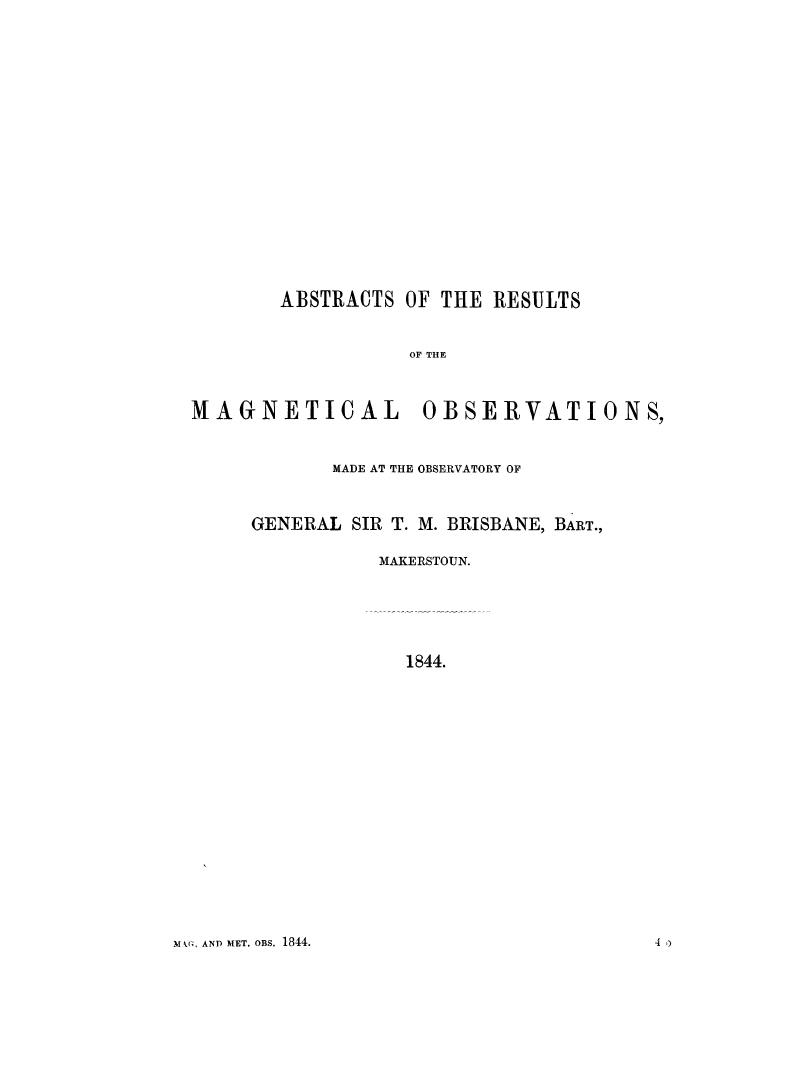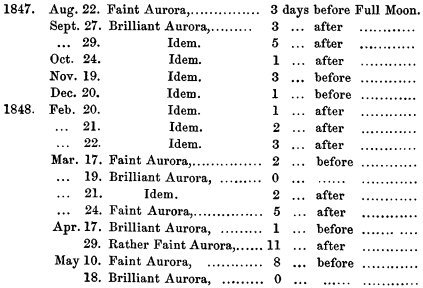No CrossRef data available.
Article contents
Results for the Magnetic Declination
Published online by Cambridge University Press: 17 January 2013
Abstract

- Type
- Abstracts of the Results of the Magnetical Observations
- Information
- Copyright
- Copyright © Royal Society of Edinburgh 1848
References
page 331 note * See the foot-notes to the Hourly Observations of Magnetometers, and the article Declinometer in the Introduction.
page 336 note * See the Plates at the end of the volume.
page 352 note * Encke, on “The Method of Least Squares.” Taylor's Scientific Memoirs, vol. ii., p. 355Google Scholar.
page 357 note * The law for the annual period of the horizontal component has been confirmed by the discussions of the observations at Makerstoun for each of the years 1842, 1843, 1844, and 1845; it has also been confirmed by a discussion of the observations made at Toronto in 1842 (see Transactions of the Royal Society of Edinburgh, Vol. xvi., pp. 102–103). Dr Lamont has not been able to conclude any distinct law from the observations made at Munich (Resultate des magnetischen Observatoriums in München, 1843–1845, p. 28); this, it appears to me, is due to the mode of discussion adopted. Dr Lamont combines the monthly means into quarterly periods, January, February, and March being the first, a mode of combination the best fitted to disguise the law, since each period includes the whole range of the variations. Neglecting the means of the Munich Observations for 1842, which were broken up in May by some instrumental causes, and considering the means for the last three years, commencing December 1842; we have the following quantities (Resultate, p. 77):—
These means include the secular change, and they follow nearly the same law of variation as the means at the foot of Table XXII.; in fact, an examination of the above quantities will shew that any elimination of secular change which is near the truth will give the law as already stated. Taking the mean secular change from 1843–1845 = 0·0018 a-year (Resultate, p. 27), and reducing the values to December at the rate of 0·00015 a-month? we obtain the following means:—
These appear to give a sufficiently distinct result; the horizontal component is a maximum in December and in June (May, June, and July having nearly the same value), and it is a minimum in April, and a principal minimum in September. This seems nearer to the results of the Makerstoun Observations than could be hoped for, when we consider the difference of instruments (Dr Lamont's having a unifilar, and the Makerstoun instrument having a bifilar suspension), and the consequent liabilities to different kinds of instrumental error.
page 395 note * Note on the Annual Variation of the Total Magnetic Force.—In the note, p. 357, it has been mentioned that the observations of the bifilar magnetometer, made at Toronto in 1842, had been discussed, and that the same law had resulted as from the Makerstoun observations. The observations of the bifilar magnetometer made at St Helena, in the four years, 1842–3–4–5, have been examined in a similar manner. The temperature coefficient has been deduced from the bifilar observations, and the observations have been corrected by it. The variations of the horizontal component at St Helena may be considered as the variations of the total magnetic force, as much at least as they are the representatives of the varying magnetic inclination at Toronto and Makerstoun. The mean of the results for the four years (three years only for the first ten weeks) indicates that the horizontal component at St Helena is a maximum in the beginning of June, and a minimum in the beginning of December: this result differs from that obtained by Colonel Sabine from two years of the same observations (chiefly, perhaps, because the results for the separate years are not very consistent among themselves.) In Colonel Sabine's result there appears to be a connection between the intensity and temperature of the air; the magnetic force appearing greatest when the temperature is greatest. Such a result would be in opposition to the well-known connection between the magnetic intensity and mean temperature at different parts of the earth's surface; in that case, the intensity seems greatest where the mean temperature is least. Perhaps, however, the St Helena Observatory is not well situated for the determination of such a connection as a general annual law, since, in the first place, the range of temperature is small (the difference between the mean temperatures of the hottest and coldest months being only 8° Fahr., about ⅓ of the difference at Makerstoun); and, in the second place, the Observatory is placed above extremely magnetic rocks; the whole island indeed is one large magnetic mass. But perhaps the result obtained from the four years' observations is the strongest objection, since it places the maximum and minimum of magnetic intensity at the two times of yearly mean temperature.
page 401 note * Mémoires de l'Académie Royale de Belgique, tome xx. Kämtz, also, in his Complete Course of Meteorology (translation by Walker, p. 458), gives a Table, comprehending 3253 auroræ. The following are the numbers by Kämtz and Hansteen:—

page 402 note * It is worth referring to the past year, as giving an illustration of the law of aurora and disturbance, as related to the moon's age. The following is a list of all the aurorae seen at Makerstoun, in the year between the solstices of 1847 and 1848:—

The aurorae marked brilliant were the most beautiful and vivid, despite the moonlight, ever observed at Makerstoun, and they were accompanied by magnetic disturbances of the same character,—the largest, it is believed, ever observed.
Neglecting the faint aurorae, it will be seen that in 8 lunations brilliant auroræ were observed within three days of full moon, only one brilliant aurora having been seen at Makerstoun farther from full moon,—namely, that of September 29. It is conceived that these observations of themselves give a great probability to the conclusion, that the maximum for the aurora and magnetic disturbance is at full moon. It is not, of course, supposed that brilliant auroræ occur only near full moon, but that they occur more frequently at that than at any other epoch; it should be remembered that what may be considered a vivid aurora in the absence of moonlight, would become faint in its presence, and vice versa.




